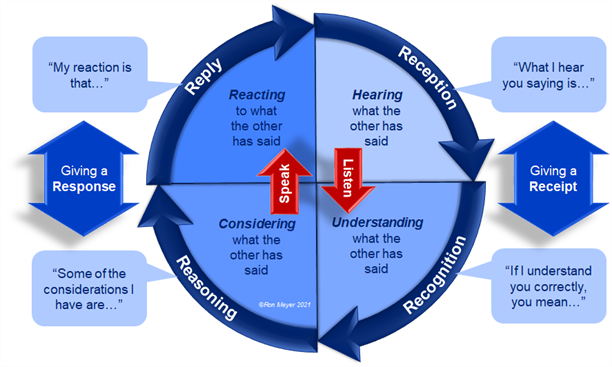Disciplined Dialogue Model
How can I talk with someone in the most fruitful way? TIAS professor of Strategic Leadership Ron Meyer presents an insightful tool to kickstart your thinking: Disciplined Dialogue Model.
Key Definitions
Managers talk all day – sometimes at other people, but mostly with them. Such conversations can be discussions, with the intention of making a point, or debates, with the intention of winning a point, or dialogues, with the intention of exploring a topic together.
Each conversation has a content and process side. The content side is what is being talked about, while the process side is how the talking takes place. Managers are often so focused on the content that the conversation process unfolds in an accidental manner.
Conceptual Model
The Disciplined Dialogue Model outlines the four steps that each participant in a dialogue should constantly cycle through in a structured way. The premise is that if you want to explore together, you must listen before you speak. Furthermore, to build on each other’s inputs you need to explicitly communicate what your listening has resulted in (called giving a receipt) before you are allowed to add something to the conversation or pose a follow-up question (giving a response). This disciplined procedure facilitates quicker mutual understanding, while by showing respect for the input of the others, also strengthens mutual trust.

Key Elements
The four steps of disciplined dialogue fall into two general categories:
A. Giving a Receipt. Listening is hard, especially if you think you already know the answer and what the others will say. That is why the discipline of repeating in your own words what your conversation partner has just said is so crucial. It forces you to park your own train of thought and actively listen to what the other means. It also shows empathy and respect, while allowing your partner to spot where you might not have fully understood. There are two steps to listening and after each a receipt can be given where useful:
1. Reception: Hearing what the other has said. Every interaction starts with opening your ears to receive the other person’s message in an unfiltered way. This is also called listening without judgement. The receipt can be a simple rephrasing of what was expressed: “What I hear you saying is...”.
2. Recognition: Understanding what the other has said. Once the message has been received, it needs to be decoded to recognize what the other has intended to convey. This is empathetic interpretation. The receipt can be your summary of what you have distilled from the message: “If I understand you correctly you mean…”.
B. Giving a Response. After listening and giving a receipt, it is time to add to the conversation, but in a way that truly builds on your partners’ input. The discipline is to actively respond, with a follow-up observation or question, instead of continuing your own line of argumentation, more or less ignoring what the other has contributed. The clearer the connection between your partners’ input and your response, the better. Here again you need to take two steps, both of which can be part of your response:
3. Reasoning: Considering what the other has said. Once you understand what your conversation partner means, you need to process this information and determine what you think about it. Your response can be to share some of the reasoning that has been triggered, almost thinking out loud: “Some of the considerations I have are…”.
4. Reply: Reacting to what the other has said. Based on the reasoning provoked by your partner, you might draw some conclusions or be left with some questions, that you then want to give back. In this case, your response is to formulate an explicit reply, as a type of relay race baton to pass to the other: “My reaction is that…”.
After moving through all four steps, your dialogue partner(s) should do the same. But even if they don’t, you can still add value to the conversation by sticking to this disciplined process.
Key Insights
• Dialogue is a type of conversation. When you talk with someone with the intention of exploring together, it is a dialogue. You can use such dialogue to co-create insights, options, and/or decisions. It is more than a conversation focused on exchanging information and views (a discussion) or one focused on proving you are right (a debate).
• Dialogue requires discipline. Building on each other is not easy or obvious, so conversations quickly degrade into discussions or debates. To have a fruitful dialogue requires a disciplined process, which can become an effortless routine with practice.
• Dialogue requires active listening. Effective dialogue hinges on the ability of each conversation partner to momentarily set aside his/her own thoughts and filters, to open-mindedly think along with the other to comprehend what she/he truly means.
• Dialogue requires active responding. Effective dialogue also depends on the ability of each conversation partner to grab the relay baton they are passed, instead of dropping it and running further with their own ideas. Each partner must actively respond to the other.
• Dialogue can be led. Ideally, all dialogue participants should use the same four steps. But even if they don’t, you can consciously steer the dialogue process by asking others for a receipt or a response, while simultaneously leading by example.
Inspired by this kickstart?
The six-day Masterclass Personal Leadership will teach you how to lead people by establishing a connection. You will learn how to identify the underlying motives of others and how to use this knowledge to shape your leadership. At the same time, you will gain insight into your own motives, leadership styles, strengths and weaknesses.
Read more »
Disciplined Dialogue Model is part 29 of a series of management models by prof. dr. Ron Meyer. Ron is managing director of the Center for Strategy & Leadership and publishes regularly on Center for Strategy & Leadership.